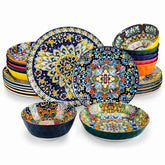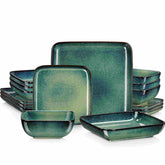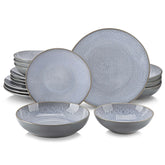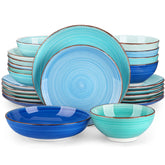Shallow vs Deep Dinner Plates: A Comparison for the Perfect Table Setting
Navigation
- Shallow and Deep Dinner Plate Designs
- Advantages and Disadvantages of Shallow Dinner Plates
- Advantages and Disadvantages of Deep Dinner Plates
- How to Mix and Match Plates for Everyday Dining
- Choose the Right Plates to Make Your Dishes Stand Out
Both shallow and deep dinner plates offer their unique aesthetic appeal. Explore how shallow and deep plates make your dining table setting stand out. The functionality of both plates is appreciable. Learning to mix and match shallow and deep plates can enrich both their practical charm and your dining experience.
Shallow and Deep Dinner Plate Designs
Shallow and deep plates are significant parts of a table setting. A complete meal course often requires the use of both types of plates. The distinctive design and functionality of both plates make them a necessary part of your daily meals. Both plates have very different designs to accommodate your unique meal consumption requirements.
Shallow plates feature flat and broad surfaces. These plates are ideal for serving dishes that require a striking presentation. Dry meals or food recipes that have less sauce are best served on shallow plates.
Deep plates have narrower surfaces and bowl-like bottoms, which prevents the contents from spilling and splashing. Deep plates are the best choice to serve foods with sauces and broths.
You can mix and match both plates to make your table setting convenient for every type of meal course. The key point is to use both deep and shallow plates functionally, recognizing the value of each type.
In the following blog, we will discuss the features, pros, and cons of both plates to give you a better understanding of their practical allure.
Advantages and Disadvantages of Shallow Dinner Plates
Shallow dinner plates are a staple in most households, known for their versatility and aesthetic appeal. These plates are typically about one inch deep, with a wide surface area that allows for a visually appealing presentation of food.
Advantages of Shallow Dinner Plates
1. Food Appears More Plentiful: One of the main benefits of shallow plates is that they make food portions appear more abundant. The wide surface area allows food to be spread out, creating the illusion of a larger portion. This can be particularly advantageous when serving smaller portions or when trying to create a more generous presentation.
2. Enhances Aroma Dispersion: Shallow plates are ideal for dishes that rely on their aromatic qualities. The wide, open design allows aromas to disperse freely, enhancing the sensory experience of the meal. This makes shallow plates perfect for dishes like grilled meats, roasted vegetables, or any meal where the smell is an integral part of the enjoyment.
3. Well-Suited for Dishes Without Much Sauce: Shallow plates are excellent for dry or less saucy foods. Think of dishes like grilled chicken, steak, or a beautifully arranged salad. The flat surface ensures that these foods remain in place, allowing for a neat and organized presentation.
Drawbacks of Shallow Dinner Plates
1. Not Ideal for Saucy Foods: Shallow plates may not contain saucy foods as effectively. Saucy or brothy dishes, such as pasta with a rich sauce or a stew, are not well-suited for shallow plates. The lack of depth can lead to spills, making it difficult to enjoy these types of meals without a mess.
2. Potential for Spills: The shallow design can also make it easier for food to spill over the edge, especially if the plate is overfilled. This can be problematic during more formal dining situations where presentation and cleanliness are paramount.
Advantages and Disadvantages of Deep Dinner Plates
Deep dinner plates, often referred to as soup plates or bowls, are designed with a more concave structure. They are typically used for dishes that require a bit more containment, such as soups, stews, or pasta dishes with sauces.
Advantages of Deep Dinner Plates
1. Help Prevent Spills from Saucy Foods: The primary advantage of deep plates is their ability to contain liquids and sauces. The depth of these plates ensures that even the soupiest of dishes can be served without fear of spilling. This makes them ideal for meals like curries, pasta dishes with rich sauces, or even a hearty stew.
2. Look More Elegant and Refined: Deep plates often have a more sophisticated and refined appearance, making them a great choice for formal dinners or when you want to impress your guests. The added depth allows for a more structured presentation of food, which can elevate the dining experience.
3. Keep Food Warmer Longer: Deep plates can also help keep food warmer for a longer period. The bowl-like design helps retain heat, making them a good option for hot dishes that you want to stay warm throughout the meal.
Drawbacks of Deep Dinner Plates
1. Food Appears Less Plentiful: One of the downsides of deep plates is that they can make food portions appear smaller. The concave design can cause food to bunch up in the center, which can create the illusion of a less generous serving. This can be a disadvantage when serving smaller portions or when you want the meal to appear more substantial.
2. May Retain Aromas More Than Desired: Unlike shallow plates, deep plates can sometimes trap aromas, preventing them from fully dispersing. This can be a disadvantage for dishes where the smell is a crucial part of the dining experience.
3. More Challenging for Presentation: The depth of these plates can make it more difficult to achieve a visually appealing presentation. Foods can end up looking cramped or piled up, which can detract from the overall aesthetic of the dish.
How to Mix and Match Plates for Everyday Dining
Understanding the strengths and weaknesses of both shallow and deep dinner plates allows you to use them more effectively in your daily life. Each style serves different purposes, and knowing when to use each can enhance your dining experience.
1. Pairing Shallow Plates with Specific Dishes: Use shallow plates for meals that are meant to be enjoyed with the eyes as much as the palate. These plates are perfect for dishes like grilled meats, roasted vegetables, or any meal that benefits from a broad, open presentation. They are also ideal for dry or less saucy foods where spills are not a concern.
2. Reserving Deep Plates for Saucy or Liquid-Based Meals: Save deep plates for dishes that have a lot of sauce or liquid. Soups, stews, pasta dishes with heavy sauces, and curries are all great candidates for deep plates. The added depth will help prevent spills and keep your table clean.
3. Mixing and Matching for a Balanced Meal: In many cases, it might be beneficial to use both types of plates during a single meal. For example, you might serve a salad or appetizer on a shallow plate and then switch to a deep plate for the main course if it involves a sauce or broth. This approach allows you to take advantage of the best features of both plate types.
4. Creating a Versatile Dinnerware Collection: To ensure that you are always prepared for any type of meal, it's a good idea to have a mix of both shallow and deep plates in your dinnerware collection. This will give you the flexibility to choose the right plate for each dish, whether you are serving a casual family meal or hosting a formal dinner party.
5. Special Occasions: For special occasions or formal dinners, deep plates can add an element of elegance and sophistication to the table setting. Pairing them with coordinating shallow plates for different courses can create a cohesive and visually appealing presentation
Choose the Right Plates to Make Your Dishes Stand Out
Choosing right dinner plates is not just about aesthetics; it's about enhancing the overall dining experience. By understanding the specific advantages and disadvantages of each type of plate, you can make informed decisions that complement the dishes you serve and the ambiance you want to create. Whether you're hosting a formal dinner party or simply enjoying a quiet meal at home, the right choice of dinnerware can make all the difference. So, don't hesitate to mix and match shallow and deep plates in your daily life, and enjoy the versatility they bring to your table.













